It looks like you're using an Ad Blocker.
Please white-list or disable AboveTopSecret.com in your ad-blocking tool.
Thank you.
Some features of ATS will be disabled while you continue to use an ad-blocker.
26
share:

Quetzalcoatlus northropi of the Cretaceous period, a pterosaur with a wingspan of some 33 feet that stood as tall as a giraffe. Like Quetzalcoatl, it was a feathered (well, sort of — more on that later) reptile, though Quetzalcoatlus had the body of a bat and the head and neck of a stork, except instead of delivering babies it delivered death. Which in a way makes it the exact opposite of a stork.
Quetz’s similarly-sized cousin Arambourgiania philadelphiae with a giraffe at left and some sort of hominid at right. Illustration: Mark Witton
But with nowhere near a complete skeleton to work with, scientists are still trying to piece together exactly how Quetz looked and behaved. How exactly could a 16-foot-tall creature even get airborne? Why wouldn’t it just fall out of the sky?
Quetz was part of a family known as the giant azhdarchid pterosaurs, which include the similarly sized Arambourgiania philadelphiae, shown at right. When in flight, their enormity would have prohibited them from vigorous flapping, so instead these were likely highly proficient gliders, according to Mark Witton, a paleontologist, paleoartist, and author of the book Pterosaurs.
He thinks Quetz would have been capable of covering some 10,000 miles nonstop — which is like flying from London to Albuquerque and back, or, if you prefer even bigger numbers, making 58,823.53 round trips from my apartment to nearest corner store — riding rising columns of hot air called thermals and hitting speeds of 80 mph. Quetz may have been able to stay aloft for more than a week, only intermittently flapping its enormous membranous wings, which were supported, believe it or not, by an extremely elongated finger (alas, not that finger).
Yet even given its aerial prowess, Quetz was likely not only highly comfortable on terra firma, but was also a formidable land predator. “Their legs are long, their extremities compact and padded, and their trackways reveal proficient walking abilities,” Witton said in an email interview with WIRED. “We figure that these attributes point to a lifestyle of ‘terrestrial stalking,’ where relatively small animals and nutritious plant matter were procured on the ground, a bit like the way that many storks and ground hornbills live today.”
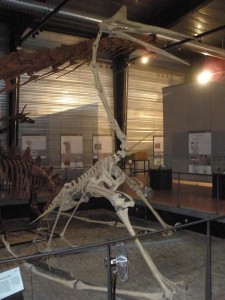
wired
Those highly elongated vertebrae hide yet another remarkable feature of Quetz: Like modern birds, it had hollow bones linked to what was likely a very efficient respiratory system. “This means the skeleton is inflated by air sacs like a set of bony balloons, growing in proportion without gaining a lot of additional weight,” said Witton. “This has obvious advantages for a flying animal, permitting the development of a very large and strong skeleton which is also very lightweight for its size.”
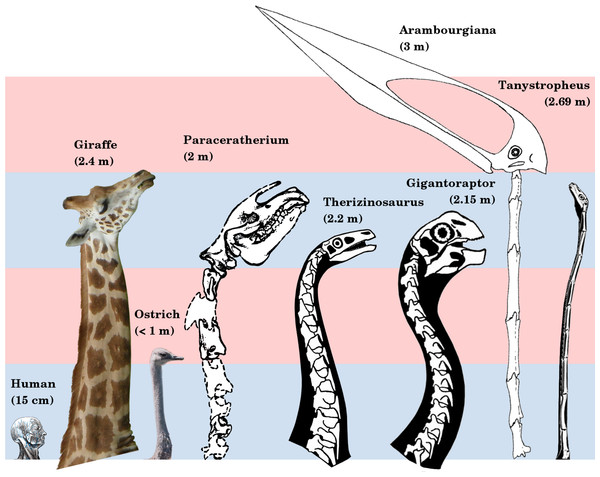
It is thought they would take to flight by bounding on all four limbs like a bat and they had plumage like a bird as a thermal barrier at high altitudes.
Anyway there is way too much for me to sum up on these creatures in a few paragraphs so click on the links to see more.
9 things you may not know about giant azhdarchid pterosaurs
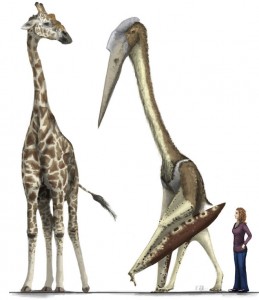
edit on 1-11-2013 by Grimpachi because: (no reason given)
That flying Giraffe of Death could quite probably snack on a human (if they were still around and the atmosphere were dense enough to allow them to
fly and we just happened to coexist with them without either of us killing off the other species into extinction).
reply to post by AliceBleachWhite
If time travel was possible I would have a field day. That is if I didn’t get eaten. The world is and always has been a very strange wonderful yet deadly place.
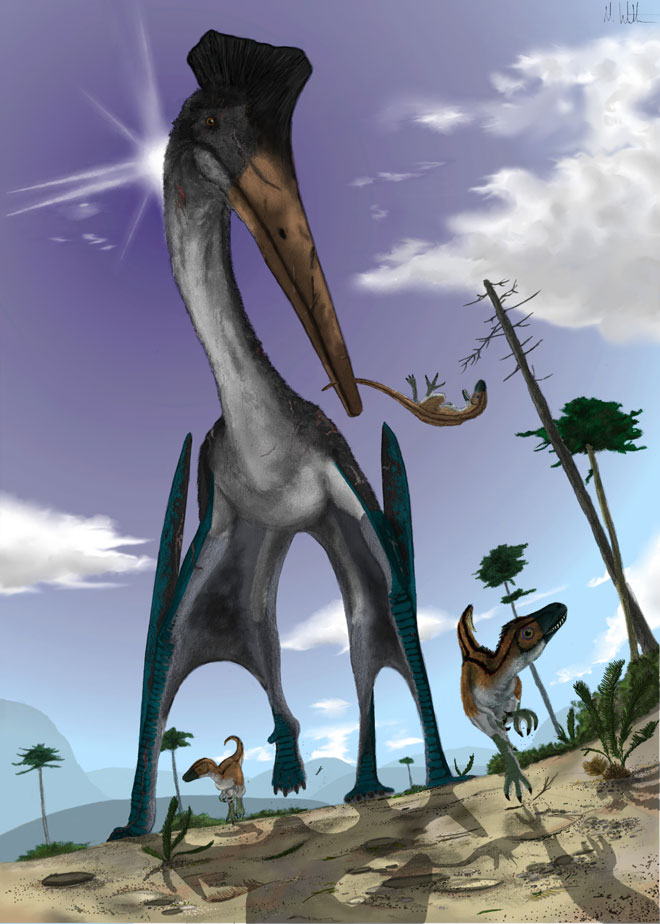
I like that pic as well
If time travel was possible I would have a field day. That is if I didn’t get eaten. The world is and always has been a very strange wonderful yet deadly place.

I like that pic as well
reply to post by Grimpachi
An even more fun thought, if these things were still around (and atmosphere was dense enough to allow them flight), we could probably ride these things!
Flying Giraffe of Death races!
Preindustrial civilization could of used these as military cavalry!
An even more fun thought, if these things were still around (and atmosphere was dense enough to allow them flight), we could probably ride these things!
Flying Giraffe of Death races!
Preindustrial civilization could of used these as military cavalry!
reply to post by Grimpachi
Now that is one interesting looking and nasty Pterosaur.
Did they share the skies with other Pterosaurs? If so, one has to wonder what that would have looked like both visually as well as from a competition between the species standpoint.
Regardless, it's definitely something I'd want to view from afar...but damn they would have been something to see...
ETA - Forgot to say thanks and S&F for sharing the info and for the cool images that are now in my head.
Now that is one interesting looking and nasty Pterosaur.
Did they share the skies with other Pterosaurs? If so, one has to wonder what that would have looked like both visually as well as from a competition between the species standpoint.
Regardless, it's definitely something I'd want to view from afar...but damn they would have been something to see...
ETA - Forgot to say thanks and S&F for sharing the info and for the cool images that are now in my head.
edit on 11/2/2013 by Riffrafter
because: see ETA...
reply to post by AliceBleachWhite
Hahahaha…I like the way you think.
Flintstones airlines.
No more like the Avatar movie. Wow that would be cool.
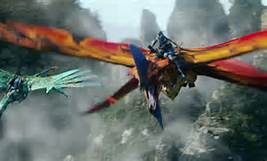
Hahahaha…I like the way you think.
Flintstones airlines.
No more like the Avatar movie. Wow that would be cool.

reply to post by Riffrafter
I was looking at the time period they were dated to have lived and it seems they did share the skies with some other species. I am not sure if they were all Pterosaurs but it would make sense that there were others during the same time period because there are other species.
It actually looks like there are too many to name.
I was looking at the time period they were dated to have lived and it seems they did share the skies with some other species. I am not sure if they were all Pterosaurs but it would make sense that there were others during the same time period because there are other species.
It actually looks like there are too many to name.
So out of curiosity, if these creatures were gliders as they are claiming then why are so many of the pictures supplied of them on the ground? I
wasn't aware that "Gliders" could lift off in any efficient fashion from that vantage point. Would it not need to climb a tree, or hill, or
something just to achieve lift?
How would it escape any predators on the ground that way?
It may sound dumb, but on this one i call mis-information. I think they, and us, are missing something essential about these creatures. Maybe the bones are put together wrong or their assumption of its flight capabilities is off.
How would it escape any predators on the ground that way?
It may sound dumb, but on this one i call mis-information. I think they, and us, are missing something essential about these creatures. Maybe the bones are put together wrong or their assumption of its flight capabilities is off.
reply to post by Thorneblood
Click on the link to the wired source article and there are two video’s addressing flight near the bottom one showing a Bat taking flight from the ground. That should put your concerns to rest.
As far as predators go they would have to be pretty big to pose a threat which would also make it very hard for them to sneak up on them.
click here for video on how they take flight
“Mike and Jim were aware that there’s more than one way for a vertebrate animal to take off,” Witton said. “Some launch using their legs alone (birds), while others take off using all four limbs, with the arms generating most of the vertical thrust during takeoff (several bat species). The latter is actually a lot stronger than a hind-limb launch, as the biggest set of muscles in the body — the flight muscles — are directly employed in generating the necessary thrust to remain airborne.”
Click on the link to the wired source article and there are two video’s addressing flight near the bottom one showing a Bat taking flight from the ground. That should put your concerns to rest.
As far as predators go they would have to be pretty big to pose a threat which would also make it very hard for them to sneak up on them.
click here for video on how they take flight
edit on 2-11-2013 by Grimpachi because: (no reason
given)
reply to post by Grimpachi
They have questions about how it could possibly fly. Maybe it was flightless despite its wings. Why not? Maybe it didn't fly place to place but just briefly like a chicken or it glided.
They have questions about how it could possibly fly. Maybe it was flightless despite its wings. Why not? Maybe it didn't fly place to place but just briefly like a chicken or it glided.
reply to post by GogoVicMorrow
The article does say
If they didn’t fly that would be a shame because even their bones were adapt to being very light.
The article does say
riding rising columns of hot air called thermals and hitting speeds of 80 mph. Quetz may have been able to stay aloft for more than a week, only intermittently flapping its enormous membranous wings, which were supported, believe it or not, by an extremely elongated finger
the skeleton is inflated by air sacs like a set of bony balloons, growing in proportion without gaining a lot of additional weight,”
If they didn’t fly that would be a shame because even their bones were adapt to being very light.
edit on 2-11-2013 by Grimpachi because: (no reason given)
I would say there is a huge difference in a bat "leaping" to gain flight and a 550 lb flying reptile as big as a giraffe. How high would it have to
jump to comfortably unfurl a 33 ft wing span and gain altitude at that weight and size?
I suppose i could see a running start if they were as skilled at walking as this article claims,
Finally, even at the size of a giraffe the Quetz was not really a big predator as i would call it. It would be easy lunch for a t-rex and despite its size and flight capabilities i believe a strong pack of raptors would make a quick meal of this thing (To name two common dino's from this era)
I say if they do not have a complete skeleton to work with then we are still missing an essential element to answer this question.
I suppose i could see a running start if they were as skilled at walking as this article claims,
Finally, even at the size of a giraffe the Quetz was not really a big predator as i would call it. It would be easy lunch for a t-rex and despite its size and flight capabilities i believe a strong pack of raptors would make a quick meal of this thing (To name two common dino's from this era)
I say if they do not have a complete skeleton to work with then we are still missing an essential element to answer this question.
If oxygen levels were higher in the atmosphere; would that help or hurt the buoyancy of this creature??
Slight differences in the Gas mixture may have big implications like they shown in Insects.
As oxygen levels increased on a lush tropical earth, the animals got larger.
I wonder what would happen to humans in that kind of environment other than getting eaten. Do mammals have this potential in oxygen rich environment?
Slight differences in the Gas mixture may have big implications like they shown in Insects.
Raising Giant Insects to Unravel Ancient Oxygen
www.sciencedaily.com/releases/2010/10/101029132924.htm
www.sciencedaily.com...
"The dragonflies were the most challenging of the insects to raise," said VandenBrooks because, among other things, there is no such thing as dragonfly chow. As juveniles they need to hunt live prey and in fact undergraduate students Elyse Muñoz and Michael Weed working with Dr. VandenBrooks had to resort to hand feeding the dragonflies daily.
"Dragonflies are notoriously difficult to rear," said VandenBrooks. "We are one of the only groups to successfully rear them to adulthood under laboratory conditions."
Once they had worked that out, however, they raised three sets of 75 dragonflies in atmospheres containing 12 percent (the lowest oxygen has been in the past), 21 percent (like modern Earth's atmosphere) and 31 percent oxygen (the highest oxygen has been).
As oxygen levels increased on a lush tropical earth, the animals got larger.
I wonder what would happen to humans in that kind of environment other than getting eaten. Do mammals have this potential in oxygen rich environment?
reply to post by AbleEndangered
Sort of, its more insects and other arthropods that had this. They lack an efficient breathing system and need a large oxygen demand so they got big when there was a lot of it but after it left only the small ones could live.
This is when the biggest arthropod lived, a giant centipede www.prehistoric-wildlife.com...
As oxygen levels increased on a lush tropical earth, the animals got larger.
Sort of, its more insects and other arthropods that had this. They lack an efficient breathing system and need a large oxygen demand so they got big when there was a lot of it but after it left only the small ones could live.
This is when the biggest arthropod lived, a giant centipede www.prehistoric-wildlife.com...
reply to post by Grimpachi
That's cool, these were some of my favorite prehistoric animals to read about. The documentary I saw showed eating dinosaur young so I think it would have to get lift pretty fast, but I don't know too much about how it did that.
That's cool, these were some of my favorite prehistoric animals to read about. The documentary I saw showed eating dinosaur young so I think it would have to get lift pretty fast, but I don't know too much about how it did that.
I saw the word reptilian.. clcked on the thread and was disappointed..
not to take away from the awsomness of this creature.. star and flagged anyway..
not to take away from the awsomness of this creature.. star and flagged anyway..
Thorneblood
I would say there is a huge difference in a bat "leaping" to gain flight and a 550 lb flying reptile as big as a giraffe. How high would it have to jump to comfortably unfurl a 33 ft wing span and gain altitude at that weight and size?
I suppose i could see a running start if they were as skilled at walking as this article claims,
Finally, even at the size of a giraffe the Quetz was not really a big predator as i would call it. It would be easy lunch for a t-rex and despite its size and flight capabilities i believe a strong pack of raptors would make a quick meal of this thing (To name two common dino's from this era)
I say if they do not have a complete skeleton to work with then we are still missing an essential element to answer this question.
Well I can't argue with that kind of reasoning so your objections are noted however I believe I am going to stick with the experts on this they seem to have done their homework.
BTW I will have to check and see if T-Rex shared the same territory or time period as these creatures.
That would have been awesome to have witnessed something so big take to the skies, if we only had a time machine then we could find out if they tasted
like chicken!!
new topics
-
Let's talk planes.
General Chit Chat: 7 hours ago -
January 6th report shows disturbing trend (nobody is shocked)
US Political Madness: 9 hours ago -
Inexplicable military simulation - virtual reality showdown in the night..
The Gray Area: 9 hours ago -
The Truth about Migrant Crime in Britain.
Social Issues and Civil Unrest: 10 hours ago
top topics
-
Trudeau Resigns! Breaking
Mainstream News: 12 hours ago, 26 flags -
January 6th report shows disturbing trend (nobody is shocked)
US Political Madness: 9 hours ago, 20 flags -
Live updates: Congress meets to certify Trump's presidential election victory
US Political Madness: 13 hours ago, 12 flags -
The Truth about Migrant Crime in Britain.
Social Issues and Civil Unrest: 10 hours ago, 10 flags -
Gravitic Propulsion--What IF the US and China Really Have it?
General Conspiracies: 14 hours ago, 9 flags -
Let's talk planes.
General Chit Chat: 7 hours ago, 5 flags -
Greatest thing you ever got, or bought?
General Chit Chat: 14 hours ago, 4 flags -
Inexplicable military simulation - virtual reality showdown in the night..
The Gray Area: 9 hours ago, 2 flags
active topics
-
January 6th report shows disturbing trend (nobody is shocked)
US Political Madness • 50 • : RazorV66 -
Judge rules president-elect Donald Trump must be sentenced in 'hush money' trial
US Political Madness • 31 • : JadedGhost -
Gravitic Propulsion--What IF the US and China Really Have it?
General Conspiracies • 16 • : YouSir -
Trudeau Resigns! Breaking
Mainstream News • 65 • : firerescue -
Greatest thing you ever got, or bought?
General Chit Chat • 21 • : rickymouse -
Islam And A Book Of Lies
Religion, Faith, And Theology • 12 • : nugget1 -
Trump says ownership of Greenland 'is an absolute necessity'
Other Current Events • 65 • : BingoMcGoof -
Let's talk planes.
General Chit Chat • 7 • : rickymouse -
Democrats Introduce Bill That Will Take Away Donald Trumps Secret Service Protection
2024 Elections • 77 • : WeMustCare -
OK this is sad but very strange stuff
Paranormal Studies • 8 • : rickymouse
26
